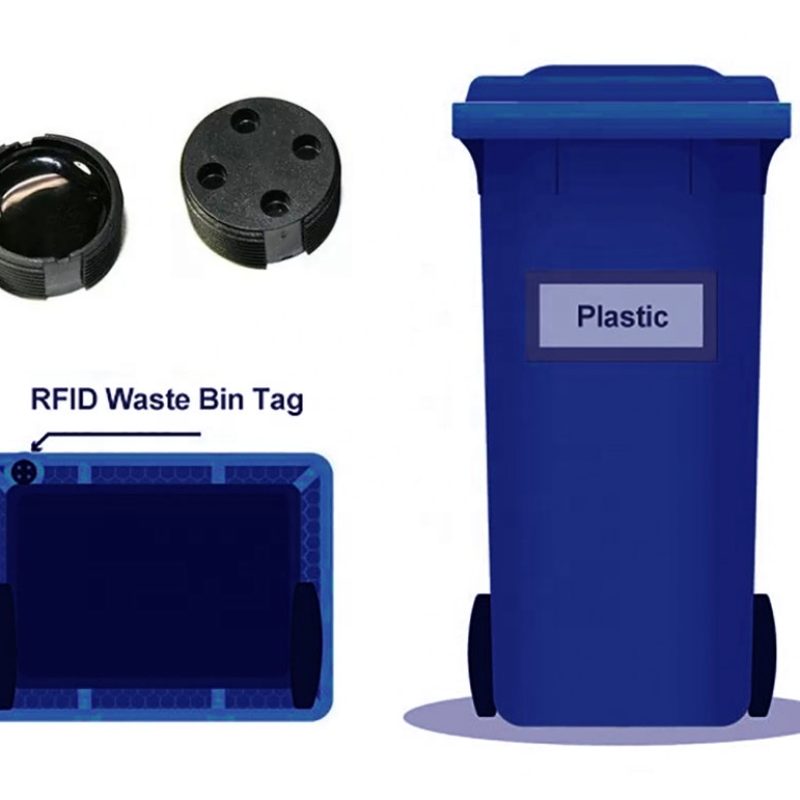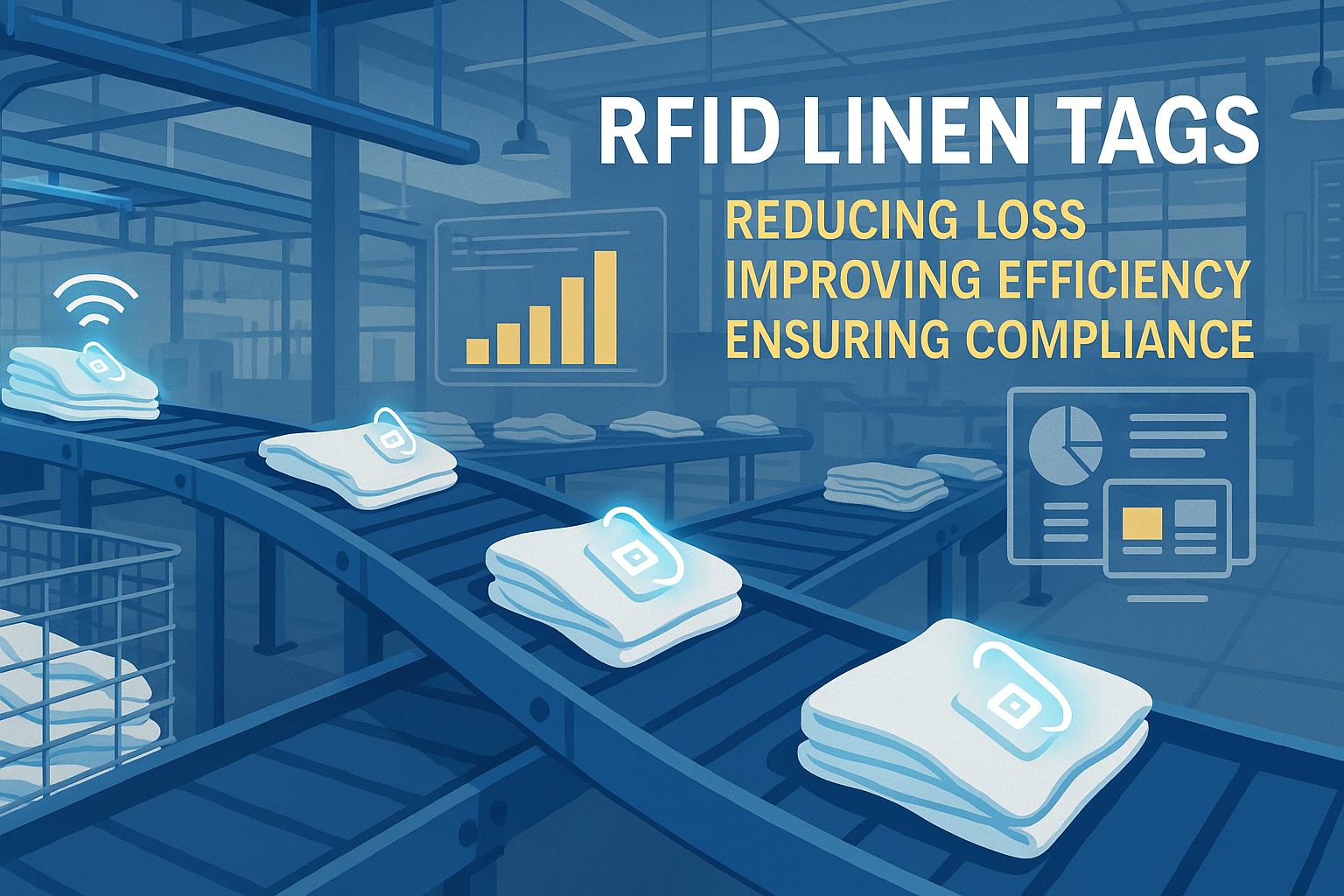
Vad är RFID-avfallshantering?
Innehållsförteckning
Introduktion till RFID-avfallshantering
“RFID, en förkortning av Radio-Frequency Identification, är en teknik som använder radiovågor för att automatiskt identifiera och spåra föremål. När den tillämpas på avfallssystem gör den det möjligt för städer och företag att spåra avfallets hela väg – från insamling till transport och bortskaffande. Det är en av de mest lovande innovationerna inom smart stadsinfrastruktur, som bidrar till att göra avfallsinsamlingen mer effektiv, transparent och miljömässigt ansvarsfull.
Vad är RFID-avfallshantering?
RFID-avfallshantering innebär att små RFID-taggar fästs på avfallskärl, säckar eller vagnar. Dessa taggar skannas av RFID-läsare som är installerade på sopbilar eller i sorteringsanläggningar. Varje skanning registrerar data som tid, plats, kärl-ID och till och med vikt.
Det är som att ge varje soptunna ett digitalt ID-kort. När sopbilen passerar vet systemet exakt vilken soptunna som har tömts, när och av vilket fordon. Detta möjliggör fullständig spårbarhet och automatisering av insamlingsprocessen.
Till exempel använder städer och privata operatörer nu RFID-taggar för soptunnor på hushållsavfallsbehållare för att verifiera upphämtningar, minska antalet missade upphämtningar och automatisera faktureringen.

Hur RFID-avfallshanteringssystem fungerar
Varje RFID-avfallshanteringssystem består av tre huvudkomponenter:
- RFID-taggar: Små elektroniska chip placerade på avfallskärl eller containrar.
- RFID-läsare: Enheter monterade på sopbilar eller vid uppsamlingsplatser som skannar taggarna.
- Backend-programvara: En hanteringsplattform som samlar in och analyserar data.
När en lastbil passerar registrerar läsaren närliggande taggar och loggar varje behållares data – plats, tid och upphämtningsbekräftelse. Denna information skickas till en databas där operatörerna kan se instrumentpaneler, prestandamätvärden och ruttloggar.
Mer avancerade system integrerar RFID-taggar för avfallskärl med sensorer som mäter fyllnadsnivåer eller vikt. I kombination med GPS och programvara för ruttoptimering hjälper RFID städer att effektivisera avfallshanteringen med precision.
Fördelar och användningsområden för RFID inom avfallshantering
Här är anledningen till att städer och företag inför RFID-avfallshantering:
- Ruttoptimering: Lastbilarna hoppar över tomma behållare, vilket sparar bränsle och tid.
- Korrekt fakturering: Stöder program där invånarna betalar efter hur mycket avfall de producerar.
- Bättre ansvarsskyldighet: Varje sophämtning loggas, vilket minskar antalet klagomål och missade hämtningar.
- Förbättrad återvinning: RFID-data hjälper till att identifiera avfallstyper för förbättrad sortering och återvinningsgrad.
Exempel på detta är kommuner som använder RFID-taggar på sopkärl för att bekräfta att tjänsten har utförts, och industrianläggningar som använder RFID för spårning av farligt avfall – vilket säkerställer efterlevnad av regler och spårbarhet.
Exempel från verkligheten och fallstudier
Städer runt om i världen använder redan RFID-avfallshantering för att modernisera sina system – och resultaten är mätbara.
Amsterdam
Amsterdam installerade RFID-taggar på alla hushållssopkärl. Resultaten var tydliga:
- 15% färre missade insamlingar
- Effektiviserade insamlingsrutter med hjälp av realtidsdata
- Betydande minskning av bränsleförbrukning och körtid
Seoul
Seouls program för betalning per användning av matavfall använder RFID-taggar på sopkärl för att spåra avfallshanteringen. Invånarna trycker på ett RFID-kort vid smarta sopkärl; systemet väger avfallet och debiterar därefter. Vissa distrikt rapporterade en minskning av matavfallet med över 30% tack vare detta system.
Privata transportörer
Privata avfallshanteringsföretag använder också RFID-teknik för avfallshantering för att:
- Spåra kommersiella upphämtningar i realtid
- Automatisera fakturering
- Identifiera serviceproblem innan kunderna ens märker dem
RFID kontra streckkodsspårning av avfallskärl
Både RFID och streckkoder används för att spåra avfallsbehållare, men teknikerna skiljer sig avsevärt åt när det gäller prestanda, automatisering och hållbarhet. I tabellen nedan jämförs de två metoderna inom viktiga områden som är relevanta för modern avfallshantering.
| Särdrag | RFID-spårning av avfallskärl | Spårning av avfallskärl med streckkod |
|---|---|---|
| Skanningsmetod | Använder radiovågor; ingen siktlinje krävs. Läsare kan automatiskt upptäcka taggar på flera meters avstånd. | Kräver direkt siktlinje. Arbetarna måste skanna varje etikett manuellt. |
| Hastighet och effektivitet | Hög – flera containrar kan skannas samtidigt, även när lastbilen är i rörelse. | Låg — endast en behållare kan skannas åt gången, vilket fördröjer insamlingen. |
| Varaktighet | RFID-taggar för avfallskärl är motståndskraftiga mot smuts, fukt och skador. | Streckkoder bleknar lätt eller täcks av smuts och repor. |
| Datakapacitet | Kan lagra detaljerade uppgifter såsom behållar-ID, ägare, vikt och historik. | Begränsad till en enkel numerisk eller alfanumerisk kod. |
| Automatiseringspotential | Helt automatiserad – integreras med IoT-sensorer, GPS och ruttoptimering. | Manuell — förlitar sig på mänskliga operatörer för skanning och registrering. |
| Initial kostnad | Högre initialkostnad (taggar och läsare), men långsiktig avkastning genom automatisering. | Låga initialkostnader, men högre löpande arbetskraftskostnader och fler fel. |
| Bäst för | Smarta städer, industrianläggningar och privata transportörer som strävar efter automatisering. | Små verksamheter eller lågbudgetsystem som behöver grundläggande identifiering. |
Sammanfattningsvis erbjuder RFID-avfallshantering en skalbar, automatiserad lösning, medan streckkodsspårning förblir ett kostnadseffektivt alternativ för nybörjare. För städer och organisationer som strävar efter långsiktig effektivitet är RFID-taggar för avfallskärl en smartare investering.
RFID-avfallshantering i industriella avfallsflöden
RFID-avfallshantering förändrar också spårningen av industriavfall. I sektorer som tillverkning, byggande och hälso- och sjukvård är efterlevnad av regler och spårbarhet icke-förhandlingsbara.
Med hjälp av RFID-taggar för avfallskärl kan företag registrera varje förflyttning av avfallsbehållare – från uppkomst till transport och slutlig avfallshantering. Taggarna registrerar tidsstämplar, hanterare och rutter, vilket garanterar fullständig spårbarhet i hela kedjan.
Sjukhus använder till exempel RFID för att spåra behållare med biologiskt farligt avfall, medan bilfabriker använder det för att övervaka metallskrot och kemiskt avfall. Uppgifterna förbättrar inte bara efterlevnaden utan identifierar också ineffektiviteter i materialflödet och avfallshanteringsprocesserna.
För branscher som står inför strikta revisioner eller hållbarhetsrapportering erbjuder RFID-avfallshantering tillförlitlig, manipuleringssäker dokumentation och operativa insikter i realtid.
Kan RFID-avfallshantering minska insamlingskostnaderna?
Absolut. Den automatisering som är inbyggd i RFID-avfallshanteringen innebär direkta kostnadsbesparingar.
Med realtidsinformation om vilka sopkärl som är fulla kan lastbilarna undvika onödiga stopp, vilket minskar bränsleförbrukningen, arbetstiden och slitage på fordonen. Städer som Amsterdam har rapporterat betydande minskningar av missade upphämtningar och ineffektivitet i verksamheten efter att ha infört RFID-taggar på sopkärlen.
Privata transportörer drar också nytta av detta: automatiserad hämtningsverifiering minimerar tvister och pappersarbete, medan programvara för ruttoptimering minskar den totala körsträckan. Med tiden möjliggör de insamlade uppgifterna smartare planering – justering av hämtningsfrekvens och placering av sopkärl för maximal effektivitet.
Även om den initiala investeringen i RFID-hårdvara är högre än för streckkoder, uppnår de flesta operatörer avkastning på investeringen inom ett till tre år genom besparingar inom logistik, bränsle och administration.
Utmaningar, fallgropar och överväganden
Även det bästa RFID-avfallshanteringssystemet har hinder:
- Kostnad: Initiala utgifter för taggar, läsare och integration.
- Tekniska faktorer: Läsningsräckvidden kan påverkas av materialet i behållarna eller miljöförhållandena.
- Dataskydd: Att koppla soptunna-ID till hushåll kräver noggrant dataskydd.
- Hållbarhet: RFID-chip innehåller elektronik som måste återvinnas på ett ansvarsfullt sätt.
- Utbildning: Arbetstagare och IT-team behöver orientering om det nya systemet.
Att först genomföra ett pilotprojekt är det bästa sättet att finjustera hårdvara och datahantering innan man går vidare till en större skala.
Steg för att implementera RFID-avfallshantering
Här är en tydlig vägkarta för kommuner eller företag som vill utforska RFID-avfallshantering:
- Definiera mål: t.ex. minska antalet missade upphämtningar med 20%, förbättra återvinningen med 15%.
- Granska nuvarande system: Identifiera typer av sopkärl, rutter och digitala verktyg som redan används.
- Välj hårdvara och mjukvara: Välj passiva eller aktiva RFID-taggar för behållare och kompatibla läsare.
- Genomför ett pilotprojekt: Testa i ett distrikt eller en anläggning.
- Skala upp: Utöka täckningen och integrera med fakturering och analys.
- Övervaka och optimera: Använd RFID-data kontinuerligt för att förfina verksamheten.
Tidig kontakt med arbetstagare, invånare och intressenter säkerställer en smidigare övergång och tydligare kommunikation.
Framtida trender och vad som väntar härnäst
Framtiden för RFID-avfallshantering ligger i en djupare integration med smarta tekniker:
- IoT-sensorer: Kombinera RFID med nivå- eller viktsensorer för övervakning i realtid.
- AI och analys: Förutse rutter och upptäck avvikelser automatiskt.
- Spårning av cirkulär ekonomi: Följ material från insamling till återvinning.
- Miljövänliga etiketter: Utveckling av återvinningsbara eller biologiskt nedbrytbara RFID-taggar för sopkärl.
- Global användning: Tillväxtmarknader integrerar RFID i initiativ för smarta städer.
Människor frågar också (FAQ)
Varför övergår städer från streckkoder till RFID-avfallshantering?
Eftersom RFID eliminerar manuell skanning. Det möjliggör automatisk behållardetektering, spårning i realtid och integration med programvara för ruttoptimering – funktioner som streckkoder helt enkelt inte kan erbjuda.
Fungerar RFID-taggar på alla typer av avfallsbehållare?
Ja. RFID-taggar för sopkärl finns i olika material (nylon, ABS, epoxi) och är konstruerade för att tåla värme, regn och mekanisk påfrestning. Det finns även specialmodeller för metallkärl eller underjordiska sopkärl.
Kan RFID och streckkoder användas tillsammans?
Det kan de – vissa hybridsystem använder streckkoder som backup eller visuell referens medan RFID hanterar den huvudsakliga datainsamlingen. De flesta moderna RFID-lösningar för avfallshantering förlitar sig dock helt på RFID för snabbhet och automatisering.
Är RFID-taggar för avfallskärl dyra?
Enskilda taggar är relativt billiga. Den största investeringen ligger i läsare och systemintegration – men driftsbesparingar från minskad arbetskraft och bränsle kompenserar snabbt dessa kostnader.
Är RFID-data säkra?
Ja. Moderna RFID-system använder krypterad kommunikation mellan taggar och läsare, vilket säkerställer att känslig insamlings- eller faktureringsdata förblir skyddad.
Slutsats
RFID-avfallshantering förändrar hur vi samlar in och övervakar avfall – det blir smartare, renare och mer ansvarsfullt.
Genom att kombinera RFID-taggar för avfallskärl, läsare och analysverktyg kan städer och företag minska kostnaderna, förbättra tjänsternas tillförlitlighet och stärka hållbarhetsmålen. Det handlar inte bara om att märka avfallskärl, utan om att skapa ett sammankopplat, effektivt ekosystem för avfallsbranschen.
Om din organisation vill minska insamlingskostnaderna, uppfylla efterlevnadskrav eller gå över till datadriven verksamhet, börja med ett litet RFID-pilotprojekt och mät effekten – en behållare, en rutt, en stad i taget.

Ray Zhou
Den här artikeln skrevs av Ray Zhou, en RFID-teknikexpert med mer än 10 års branscherfarenhet.
Kommentarer
Heta produkter

Vad är RFID-avfallshantering?
Föreställ dig en stad där varje sopkärl talar – inte bokstavligt talat – utan genom ett litet chip som meddelar systemet när det är fullt, när det töms och vart det har tagits. Det är vad RFID-avfallshantering gör idag.

Vad är bultförseglingar och deras användningsområden? | Komplett guide
Inom global handel och logistik spelar bultförseglingar en avgörande roll för att säkerställa godssäkerhet och efterlevnad. Dessa små men kraftfulla enheter är utformade för att låsa fraktcontainrar, släpvagnar och lastdörrar med en manipuleringssäker mekanism.

Vad är ett RFID-kortskydd? Fördelar, användningsfall och köpguide
RFID-teknik (Radio Frequency Identification) finns överallt: i dina kreditkort, ID-brickor, färdbevis, hotellrumsnycklar och mycket mer. Det ger snabbhet och bekvämlighet, men det öppnar också dörren för en ny typ av digital stöld som kallas "skimming". Det är där ett RFID-kortskydd kommer in i bilden.

RFID-armband för evenemang: Guide för storköp för arrangörer
RFID-armband för evenemang håller på att bli lösningen för arrangörer som behöver snabbare inträde, bedrägeribekämpning och kontantlösa betalningar på konserter, festivaler och idrottsarenor. Till skillnad från pappersbiljetter eller QR-koder använder dessa smarta armband inbäddade chips för att effektivisera åtkomst, säkra transaktioner och förbättra gästupplevelsen.

Hur RFID-taggar på vindrutan förbättrar passerkontroll och vägtullsystem för fordon
I dagens snabba värld måste fordonsidentifiering vara snabb, säker och kontaktlös. En RFID-tagg på vindrutan ger exakt det - ett tillförlitligt sätt att hantera vägtullar, parkering och gated access utan att stoppa fordon.

Fördelarna med RFID-linnetiketter i kommersiella tvätterier
Att hantera tvätten på sjukhus, hotell eller stora tvätterier är ett stort jobb. Varje dag tvättas, sorteras och skickas tusentals lakan, handdukar och uniformer tillbaka ut. Men problem som borttappade sängkläder, sorteringsmissar och manuell räkning kan kosta företagen mycket pengar. Till exempel kan medelstora hotell förlora över $200.000 varje år på grund av borttappade sängkläder.
Det är där RFID Linen Tags kommer in i bilden.




